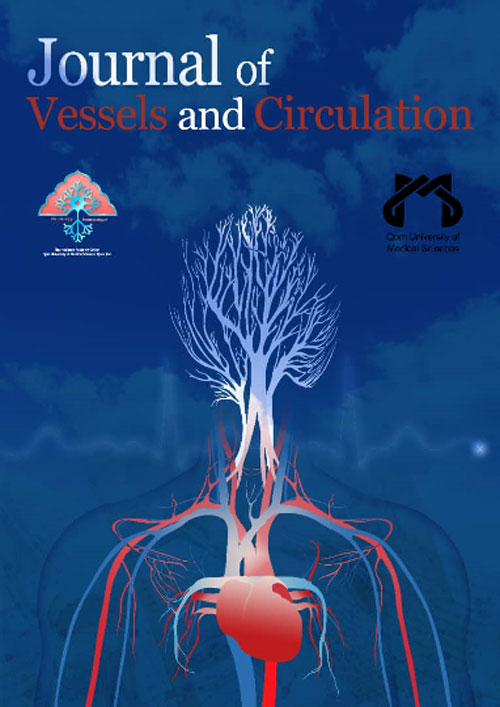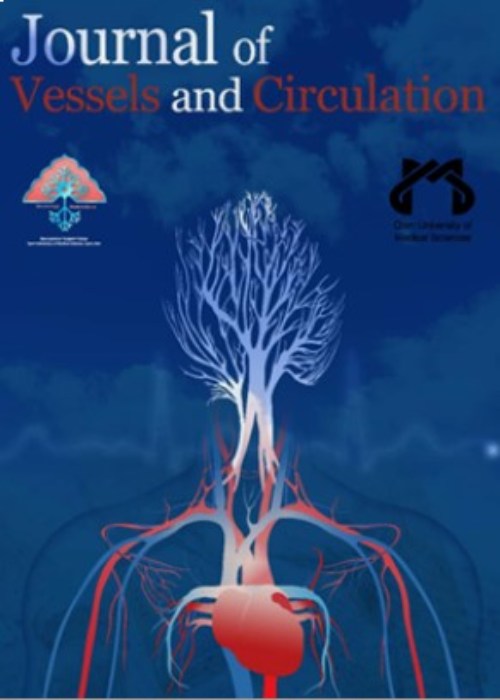فهرست مطالب

Journal of Vessels and Circulation
Volume:2 Issue: 3, Summer 2021
- تاریخ انتشار: 1401/05/02
- تعداد عناوین: 7
-
-
Pages 99-104Background and aim
Treatment of hyperlipidemia, as a major risk factor of cardiovascular disease with the leading role in atherosclerosis and cardiovascular adverse effect, is now a medical dilemma worldwide. Notwithstanding the comprehensive knowledge about the impact of this factor on cardiovascular system, successful achievement of therapeutic goals of medical therapy still remains an unattained desire. The aim of this study is to evaluate the underlying causes apart from medication itself.
Materials and MethodsThis study was performed cross-sectional. In this study, which was conducted for 6 months from March 2016, 50 patients were fully evaluated and followed up. Inclusion criteria for patients with acute myocardial infarction were newly diagnosed when the first full dose of statin (Atorvastatin 80 mg) was started for them. Exclusion criteria were history of taking fat-reducing drugs before the study. Predetermined data extraction forms including medical and laboratory variables and the Multidimensional Scale of Perceived Social Support Questionnaire (MSPSS) were completed for all patients at the first visit and after 6 months. Data were analyzed using SPSS software.
ResultsAmong 50 patients completely reviewed, 28 were men (56%) and 22 were women (44%) (P˃ 0.05), with the mean age of 60 (±10.19) years old. Only 20 patients (40%) could achieve therapeutic goal of LDL-c (˃ 70 mg/dl). Irregular drug consumption was the only factor significantly differed between patients who achieved the goals and those could not achieve (P= 0.034). Subgroup analysis among patients with regular and irregular drug consumption demonstrate that low educational level along with poor socio-economic support were significantly differed between these patients (P˃ 0.05).
ConclusionThere are some conditions independently influence the efficacy of a medical treatment to improve hyperlipidemia including educational and socio-economic determinants, apart from issues related to medication itself. Therefore, patient’s lifestyle and their condition have to be considered in planning a medical therapy.
Keywords: Hyperlipidemias, Hydroxymethylglutaryl-CoA Reductase Inhibitors, Treatment Failure, Social support -
Pages 105-114Background & Aims
Unfortunately, AIDS is one of the diseases with high morbidity and mortality due to its ease of transmission, secrecy, severe complications and lack of definitive treatment. The aim of this study was to investigate the epidemiology of HIV in Qom province.
MethodsThis cross-sectional study was performed on AIDS patients referred to the Behavioral Diseases Counseling Clinic in Qom province from its establishment until the first half of 1398. Sampling was done by census and reviewing all the registered files in the Behavioral Diseases Counseling Clinic. Criteria for data entry were completed patient records, and records of patients who were incomplete or had other sexually transmitted diseases as well as neurological disorders were excluded from the study. After data collection, Data entry was performed in SPSS software version 22.
Results612 people were studied in this study. The mean age of patients was 36.63 ± 9.41 years. 523 patients were male (85.5%) and 89 patients were female (14.5%). The number of single people was 217 (39.6%), divorced 89 (16.2%) and death of spouse 12 (2.2%). Most of the people had 221 (42.5%) primary education and only 3 (0.6%) had a bachelor's degree. Most urban patients were 501 (97.9%), unemployed 323 (58.7%). History of addiction 403 (83.4%), frequency of injecting drug use 392 (95.7%), history of injection among injecting drug users 345 (95%), frequency of extramarital sex 277 patients (66.1%), frequency of sexual intercourse 245 ( 96.1%), the frequency of condom use was 26 patients (10.4%), the frequency of child infection was found in parents with 18 patients (7.8%). The prevalence of HIV infection in Qom until 2012 was about 477 people, which is 1151,672 people compared to the population of this province according to the 2011 census registered in the Statistics Center of Iran. It was 0.041%.
ConclusionAccording to the mentioned studies and especially the national statistics regarding the change of the main method of transmission from injection to sex and the change of the transfer method from 1997 to 2013 in Qom province, it can be concluded that Qom province is also changing method. The main transition goes to sexual transmission.
Keywords: AIDS, epidemiology, HIV -
Pages 115-120Introduction & Objective
The aim of this study was to investigate the relationship between congenital heart disease in fetal echocardiography with high NT size in fetal ultrasound in mothers referring to Hazrat Masoumeh Hospital in 2019.
Materials and MethodsIn this analytical study, information of all pregnant women who underwent ultrasound screening in the first trimester of pregnancy and their NT size was determined, as well as information from fetal echocardiographic results in the next stage. Fetal echocardiography was extracted from the files and then the relationship between cardiovascular abnormalities with NT size and variables such as birth, weight, gestational age and sex in these mothers were checked and examined. Finally, the relationship between congenital heart defects and NT size was investigated using t-test.
ResultsThe mean size of NT in 152 neonates without cardiovascular disease was 1.67. 0.3 and this value was 0.5 ± 1.86 mm in 40 neonates with cardiovascular disease. Also, a statistically significant relationship was found between NT size and cardiovascular disease in neonates (P = 0.00). There was also a statistically significant relationship between neonatal gender (P = 0.71), maternal age (P = 0.88), between number of pregnancies (P = 0.26), NT size (P = 0.76), type of pregnancy (P = 0.63), gestational age (P = 0.4), and NT size was not found on ultrasound.
ConclusionFetal echocardiography is a non-invasive method for early detection of congenital heart disease that is suitable not only in high-risk pregnancies but also in low-risk pregnancies. Increased NT size is also associated with cardiovascular disease in infants.
Keywords: Nuchal Translucency, Congenital Heart Defect, Echocardiography -
Pages 121-128Background and Aims
Hypertension is one of the leading cause of chronic kidney disease(CKD). Neutrophil gelatinase-associated lipocalin (NGAL) has been known as a novel and sensitive biomarker in acute and chronic renal injury. The present study aimed to investigate serum and urinary NGAL as a marker of kidney damage in hypertensive and CKD patients.
Materials and MethodsThis case-control study was performed on 28 hypertensive patients, 28 patients with CKD and 33 healthy volunteers. Serum and urinary NGAL levels were measured using ELISA method. Creatinine and urea concentrations were measured according to the routine methods. Receiver-operating characteristic (ROC) curve analysis was employed to find the best serum and urinary NGAL cut-off values for detection of the renal function.
ResultsBoth serum and urinary NGAL levels were higher in CKD patients than in hypertensive patients and healthy controls (193.48 (96.14–263.43) vs 99.47 (29.14–132.21) vs 48.74 (27.09–64.61), P < 0.001; 63.78 (20.00–82.00) vs 23.24 (8.00–33.00) vs 11.36 (2.15–14.26), P <0.001).There was a significant positive correlation between serum and urinary NGAL with serum urea and creatinine. Serum and urinary NGAL levels showed a significant inverse correlation with eGFR. In ROC analysis, serum NGAL had the best diagnostic profile with an AUC of 0.938 (95% CI: 0.865–0.978) and a best cut-off value of 64.61 ng/ml (sensitivity 97.73%; specificity 77.27.0%).
ConclusionsThese results revealed that serum NGAL is a reliable marker for early diagnosis of renal injury in hypertensive patients.
Keywords: Chronic kidney disease, Hypertension, Neutrophil gelatinase-associated lipocalin (NGAL) -
Pages 129-136Background and Objectives
Voluntary activity decreases in the elderly, and this causes many physical problems and cardiovascular risk factors in these people. The aim of this study was to investigate the effect of 8 weeks of selected aerobic exercise in water on some cardiovascular risk factors in overweight elderly men.
MethodsAfter measuring anthropometric indices, 34 overweight men (age: 64/84± 5/56) (≥ 25 Kg/m BMI) were randomly selected and divided into two groups of exercise in water (n = 17) and control (n = 17). The exercise program included aerobic exercise in water with an intensity of 45 to 65% of maximum heart rate for 8 weeks. Before and after the intervention, blood samples were taken from all subjects to measure serum levels of triglyceride (TG), total cholesterol (TC), LDL cholesterol and HDL cholesterol. Shapiro-Wilk test was used to evaluate the normality of data distribution and after assuming the normality of the data, correlated t-test was used to examine intragroup changes and independent t-test was used for intergroup differences. Data analysis was performed using SPSS software. The results were evaluated at a significance level of less than 0.05.
ResultsExercise in water led to a significant reduction in the percentage of fat (P£0.03), weight (P£0.01), body mass index (P£0.01), blood pressure (P£0.001), TG (P£0.00), Cholesterol (P£0.01), LDL (P£0.02), But there was no significant difference in HDL index between the two groups.
Conclusion8 weeks of aerobic exercise in water can probably have positive effects on reducing some cardiovascular risk factors in overweight older men. Therefore, these exercises can be used to recommend exercise by sports and health experts in these people.
Keywords: Elderly, aerobic exercise in water, Heart Disease Risk Factors, overweight -
Pages 137-144Background
The novel coronavirus (COVID-19) disease is a global pandemic of different severity ranging from a mild respiratory disease to severe septic shock. Previous studies have established the association of acute stroke and COVID-19. Herein, we aimed to describe the characteristics of patients with stroke during COVID-19 pandemic.
Methodin this cross sectional study, all patients with acute stroke who referred to Bouali hospital were enrolled from March to June 2020. The patients were categorized into two groups with and without COVID-19. In the following, the demographic and clinical characteristics of stroke patients in both groups were evaluated. Eventually SPSS software version 22 was used to analyze the data.
Results61 patients with acute stroke were identified in which 22 patients were positive for COVID-19. Except for the in-hospital mortality (P=0.07) and type of hemorrhagic transformation (P=0.02), we did not find a significant difference in the demographic and clinical characteristics of patients in both groups. The majority of patients with COVID-19 were severely symptomatic. However, the severity of chest CT involvement was statistically correlated with the mean mRS (P=0.05).
ConclusionIn this study, we revealed acute stroke affected COVID-19 patients with traditional stroke risk factors at an age typically seen in non-COVID populations which mainly constitute cryptogenic acute ischemic stroke. We also noted a higher in-hospital mortality rate in patients with COVID-19 associated stroke which reflects a worse outcome of COVID-19. These results highlight the possible hypercoagulopathy state associated with COVID-19 which predisposes patients to develop stroke.
Keywords: cerebrovascular accident, stroke, CVA, COVID-19, SARS-CoV2, novel coronavirus -
Pages 145-150Background and Objectives
Arsenic is an environmental pollutant that can cause tissue damage by producing free radicals. However, regular aerobic exercise plays an important role in enhancing antioxidant defense and resistance to oxidative stress. Therefore, the aim of this study was to evaluate the effect of aerobic exercise on GSH and GSSG of heart tissue and aortic endothelial cells of rats exposed to arsenic.
MethodsIn this experimental study, 24 male Wistar rats with weight range (240-220 g) and mean age (6-8) weeks were divided into 3 groups of 8. Mice receiving arsenic were given 25 ppm arsenic daily in oral water for 8 weeks. The training program consisted of 8 weeks of aerobic training, five sessions per week with an intensity of 75-80% of maximum oxygen consumption. 24 hours after the last fasting training session, the rats were anesthetized and killed and the target tissue was removed for examination. Kalmogorov-Smirnov statistical test, one-way analysis of variance with Tukey post hoc test in SPSS software version 22 were used to analyze the findings(p≤0.05).
ResultsExposure to arsenic significantly reduced GSH and GSSG levels in heart tissue and aortic endothelial cells (p≤0.05). While aerobic exercise increased SGH and GSSG levels in heart tissue and aortic endothelial cells in arsenic poisoned rats (p≤0.05).
ConclusionIt seems that aerobic exercise is effective in reducing oxidative stress and increasing antioxidant defense against arsenic poisoning in heart disorders.
Keywords: Aerobic Exercise, Glutathione resuscitation, Glutathione Oxide, Arsenic


